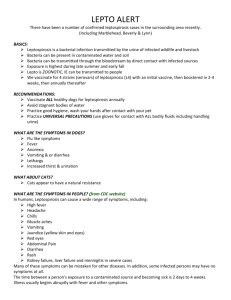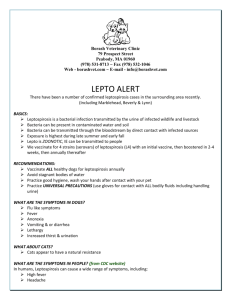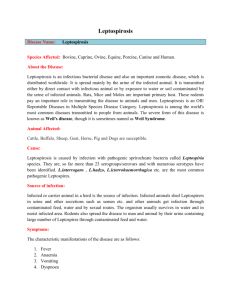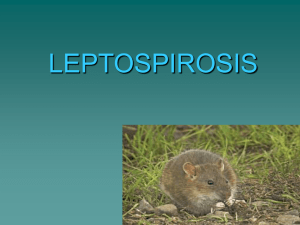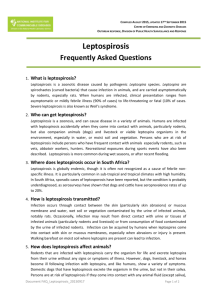Leptospirosis - Cherry Hill Animal Clinic
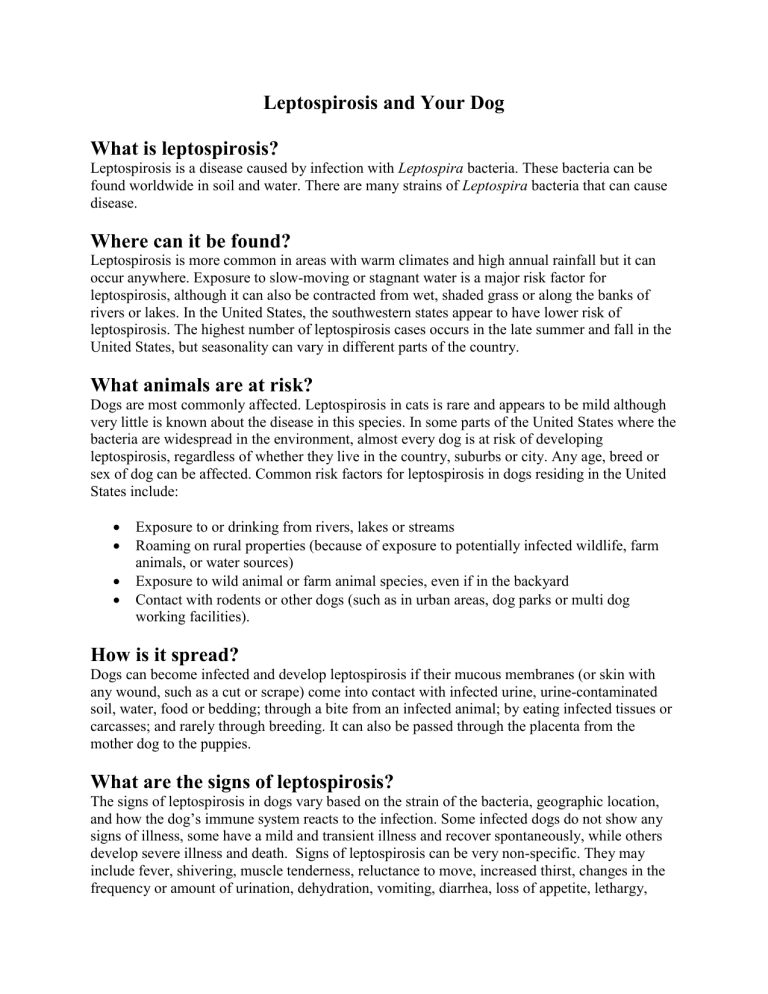
Leptospirosis and Your Dog
What is leptospirosis?
Leptospirosis is a disease caused by infection with Leptospira bacteria. These bacteria can be found worldwide in soil and water. There are many strains of Leptospira bacteria that can cause disease.
Where can it be found?
Leptospirosis is more common in areas with warm climates and high annual rainfall but it can occur anywhere. Exposure to slow-moving or stagnant water is a major risk factor for leptospirosis, although it can also be contracted from wet, shaded grass or along the banks of rivers or lakes. In the United States, the southwestern states appear to have lower risk of leptospirosis. The highest number of leptospirosis cases occurs in the late summer and fall in the
United States, but seasonality can vary in different parts of the country.
What animals are at risk?
Dogs are most commonly affected. Leptospirosis in cats is rare and appears to be mild although very little is known about the disease in this species. In some parts of the United States where the bacteria are widespread in the environment, almost every dog is at risk of developing leptospirosis, regardless of whether they live in the country, suburbs or city. Any age, breed or sex of dog can be affected. Common risk factors for leptospirosis in dogs residing in the United
States include:
Exposure to or drinking from rivers, lakes or streams
Roaming on rural properties (because of exposure to potentially infected wildlife, farm animals, or water sources)
Exposure to wild animal or farm animal species, even if in the backyard
Contact with rodents or other dogs (such as in urban areas, dog parks or multi dog working facilities).
How is it spread?
Dogs can become infected and develop leptospirosis if their mucous membranes (or skin with any wound, such as a cut or scrape) come into contact with infected urine, urine-contaminated soil, water, food or bedding; through a bite from an infected animal; by eating infected tissues or carcasses; and rarely through breeding. It can also be passed through the placenta from the mother dog to the puppies.
What are the signs of leptospirosis?
The signs of leptospirosis in dogs vary based on the strain of the bacteria, geographic location, and how the dog’s immune system reacts to the infection. Some infected dogs do not show any signs of illness, some have a mild and transient illness and recover spontaneously, while others develop severe illness and death. Signs of leptospirosis can be very non-specific. They may include fever, shivering, muscle tenderness, reluctance to move, increased thirst, changes in the frequency or amount of urination, dehydration, vomiting, diarrhea, loss of appetite, lethargy,
jaundice (yellowing of the skin and mucous membranes), or painful inflammation within the eyes. The disease can cause kidney failure with or without liver failure. Dogs may occasionally develop severe lung disease and show high respiratory rates (breath rates) and have difficulty breathing. Leptospirosis can cause bleeding disorders, which can lead to blood-tinged vomit, urine, feces (stool) or saliva; nosebleeds; and pinpoint red spots (which may be visible on the gums and other mucous membranes or on light-colored skin). Affected dogs can also develop swollen legs (from fluid accumulation) or accumulate excess fluid in their chest or abdomen.
How is it diagnosed and treated?
Leptospirosis may be suspected based on the exposure history and signs shown by the dog, but many of these signs can also be seen with other diseases. In addition to a physical examination, your veterinarian may recommend a number of other tests such as blood tests, urine tests, radiographs (x-rays), and an ultrasound examination. Tests that might be used to help diagnose leptospirosis include tests for antibody production (performed on blood) and tests for the DNA of the organism (performed on blood and urine). The tests recommended are usually based on the severity of disease and the signs observed. Leptospirosis is generally treated with antibiotics and supportive care. Depending on the severity of their illness, affected dogs may require fluid therapy, and/or nutritional support. In extreme cases oxygen therapy, mechanical ventilation
(support for breathing), kidney dialysis, or other intensive care measures might be necessary.
When treated early and aggressively, the chances for recovery are good but there is still a risk of permanent residual kidney or liver damage. When warranted, early referral for kidney dialysis, which gives the kidneys time to mend, can be life saving for dogs if finances allow. Dogs with severe respiratory disease are less likely to recover despite treatment. Other dogs in the household may also need to be treated for leptospirosis, even if they do not yet appear ill.
Are people at risk?
Yes . Leptospirosis is a zoonotic disease, which means it can be spread from animals to people.
Infection can cause flu-like symptoms and can cause liver or kidney disease. In the United
States, most cases of human leptospirosis result from recreational activities involving water.
Infection resulting from contact with an infected pet is much less common, but it is possible.
How is it prevented?
Currently available vaccines effectively prevent leptospirosis and protect dogs for at least 12 months. Contrary to some beliefs, these vaccines are no more likely to cause adverse reactions than are the other commonly administered vaccines. Annual vaccination is recommended for at-risk dogs. Reducing your dog’s exposure to possible sources of the Leptospira bacteria can reduce its chances of infection. This may include the following:
Avoid letting your dog drink from or swim in rivers, lakes, ponds, marshy areas or slow-moving or stagnant water;
Minimize contact with wildlife, farm animals and rodents, including carcasses.
Although an infected pet dog presents a low risk of infection for you and your family, there is still some risk.
If your dog has been diagnosed with leptospirosis, take the following precautions to protect yourself
Administer antibiotics properly as prescribed by your veterinarian
Avoid contact with your dog’s urine
Wear gloves when cleaning up urine
If your dog urinates in your home, quickly clean the area with a household disinfectant
Encourage your dog to urinate away from standing water or areas where people or other animals will have access
Wash your hands after handling your pet
If you are ill or if you have questions about leptospirosis in people, consult your physician. If you are pregnant or immunocompromised (due to medications ,cancer treatment, HIV or other conditions), consult your physician for advice.
Although this brochure provides basic information about leptospirosis, your veterinarian is always your best source of health information. Consult your veterinarian for more information about leptospirosis and its prevention.
This brochure was developed with assistance from the American College of Veterinary Internal
Medicine (ACVIM)
For more information, visit,
American Veterinary Medical Association www.avma.org
American College of Veterinary Internal Medicine www.acvim.org
